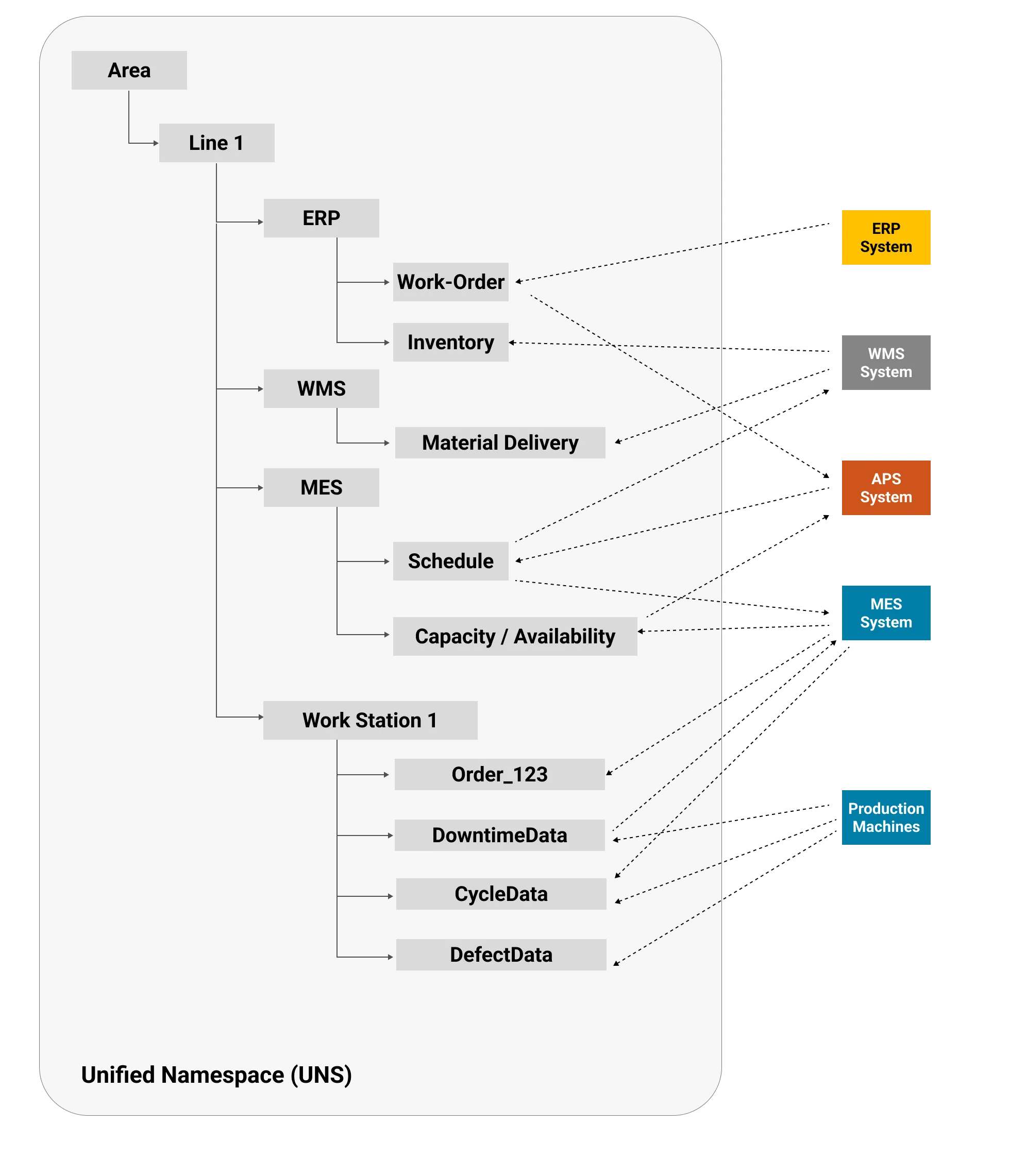Enabling Real-Time OEE and Production Analytics with a Unified Namespace (UNS)
Overall Equipment Effectiveness (OEE) has long been a crucial metric for gauging how effectively manufacturing resources are being utilized. Traditionally, many manufacturers measured OEE using manual methods—recording data on spreadsheets or relying on time-consuming data entry processes that are prone to delay and error. However, with the rise of digitalization, companies now have the tools to continuously capture and analyze machine performance data for real-time insights.
By integrating OEE tracking into a broader digital strategy—one that spans from the shop floor PLCs to the ERP and MES systems—manufacturers can better understand their true capacity, identify hidden inefficiencies, and respond more quickly to changing conditions.
In this blog post, you’ll learn how Unified Namespace (UNS) architecture plays a central role in this transformation. It enables the aggregation of machine, operator, and systems data into a single, standardized communication layer, enabling powerful analytics and faster, more informed decision-making. Let’s dive in.
Challenges in Traditional OEE and Production Analytics Tracking
Despite the importance of OEE, many plants still use fragmented systems or partially manual procedures to track performance. These common pain points illustrate the hurdles in achieving timely and accurate OEE insights:
Limited Real-Time Visibility
For example, a production line experiences minor stoppages due to material shortages or quality issues. Operators only notice these delays after the fact, making it difficult to respond quickly or log them accurately.
By the time the data is reviewed, the opportunity to correct the issue has passed. Over time, these minor stoppages accumulate, reducing output without a clear, measurable cause in the official records.
Disconnected Data Systems
PLC data (e.g., machine state and production counts) resides in local controllers, while OEE calculations happen in a separate analytics tool that receives updates intermittently. Inconsistent or delayed data prevents managers from seeing accurate performance metrics in real time, hindering proactive decision-making.
Inefficient Handling of Production Losses
Operators only detect issues once output falls significantly, causing extended downtime for troubleshooting. Product scrap or startup scrap goes unnoticed until operators manually record it, which may happen hours or days later, obscuring the root cause.
Manual KPI Tracking
Some plants rely on spreadsheets to note machine run times, planned downtimes, and output counts. This method is highly susceptible to error, requires extensive labor, and rarely provides the granular data needed to pinpoint inefficiencies in real time.
Requirements for Digitalized OEE and Production Analytics
To move from reactive to proactive performance monitoring, manufacturers need the following capabilities:
Automated, Real-Time Data Capture
PLCs should continuously publish machine status, production counts, rejects, and other operational data.
Systems like MES or real-time analytics platforms should subscribe to these data feeds, eliminating manual updates.
Integrated Dashboards and Alerts
Operators and managers require live dashboards displaying OEE metrics (availability, performance, quality) to quickly identify deviations.
Real-time alerting mechanisms help staff respond to minor stoppages or potential speed reductions before they escalate.
Closed-Loop Inventory and ERP Updates
As production data is captured, the ERP system should automatically adjust material consumption and finished goods inventory.
This ensures that stock levels remain accurate without requiring manual reconciliation.
Granular Tracking of Big Losses
Minor stoppages, reduced speed, product scrap, and startup scrap must be logged at the moment they occur, alongside contextual machine data.
This approach allows targeted, data-driven strategies to reduce or eliminate those losses.
Historical Trend Analysis
Beyond real-time monitoring, teams need to analyze OEE trends over hours, shifts, days, or weeks to see how changes in process, equipment, or workforce impact performance. This long-term view guides continuous improvement initiatives and fosters strategic planning.
Unified Data Model for Ease of Integration
A “single source of truth” for production data—such as a Unified Namespace—enables different systems (ERP, MES, analytics tools) to subscribe and publish without building multiple point-to-point connections.
This architecture scales easily and maintains data integrity across the entire organization.
How the UNS Framework Enables Effective Digitalization of OEE and Production Analytics
A Unified Namespace enables digitalized OEE tracking and production analytics by ensuring a consistent, unified, and standardized flow of data among equipment, control systems, and enterprise-level tools. Below is how the UNS architecture supports the essential components of a modern, digital OEE solution.
Real-Time Machine Data Publishing
During operation, each machine’s PLC continuously publishes status updates (running, idle, paused), production counts, and reject quantities to topics in the UNS (e.g., /work_station_1/plc_data).
Subscribing systems—like the MES, real-time analytics platform, or dashboards—immediately receive these updates, enabling live OEE calculations and proactive alerts.
 OEE Dashboards and Analytics
OEE Dashboards and Analytics
The UNS consolidates all relevant data points (e.g., planned production time, actual run time, good parts vs. rejects, etc.), simplifying the calculation of OEE and TEEP (Total Effective Equipment Performance).
An OEE dashboard namespace might combine machine states, cycle times, reject rates, and quality logs for contextualized display so that operators can see at a glance how well each station or line is performing. This real-time context helps them respond quickly to minor stoppages or deviations in machine speed.
The data collected via the UNS can be stored in a time-series database or analytics platform. Managers and engineers can then analyze historical performance by hour, shift, product type, or any other dimension.
By embracing digital OEE tracking and aligning it with real-time data streams in a Unified Namespace architecture, companies gain the clarity and responsiveness they need to minimize losses, maximize output, and optimize resources. From PLC data publishing through ERP inventory adjustments to advanced analytics dashboards, the UNS framework ensures every stakeholder has immediate, accurate visibility into machine performance.
With this holistic, integrated approach, manufacturers can spot early warning signs, eliminate bottlenecks, and reduce scrap—all while driving continuous improvement for sustained profitability and market competitiveness.
Conclusion
A Unified Namespace transforms OEE from a lagging indicator into a real-time performance tool. By centralizing machine, operator, and system data into a single source of truth, manufacturers gain immediate insights and, consequently, the ability for timely intervention to reduce losses and drive continuous improvement. This integrated approach not only boosts productivity but also creates a scalable foundation for smarter, data-driven operations.

Kudzai Manditereza
Kudzai is a tech influencer and electronic engineer based in Germany. As a Sr. Industry Solutions Advocate at HiveMQ, he helps developers and architects adopt MQTT and HiveMQ for their IIoT projects. Kudzai runs a popular YouTube channel focused on IIoT and Smart Manufacturing technologies and he has been recognized as one of the Top 100 global influencers talking about Industry 4.0 online.
